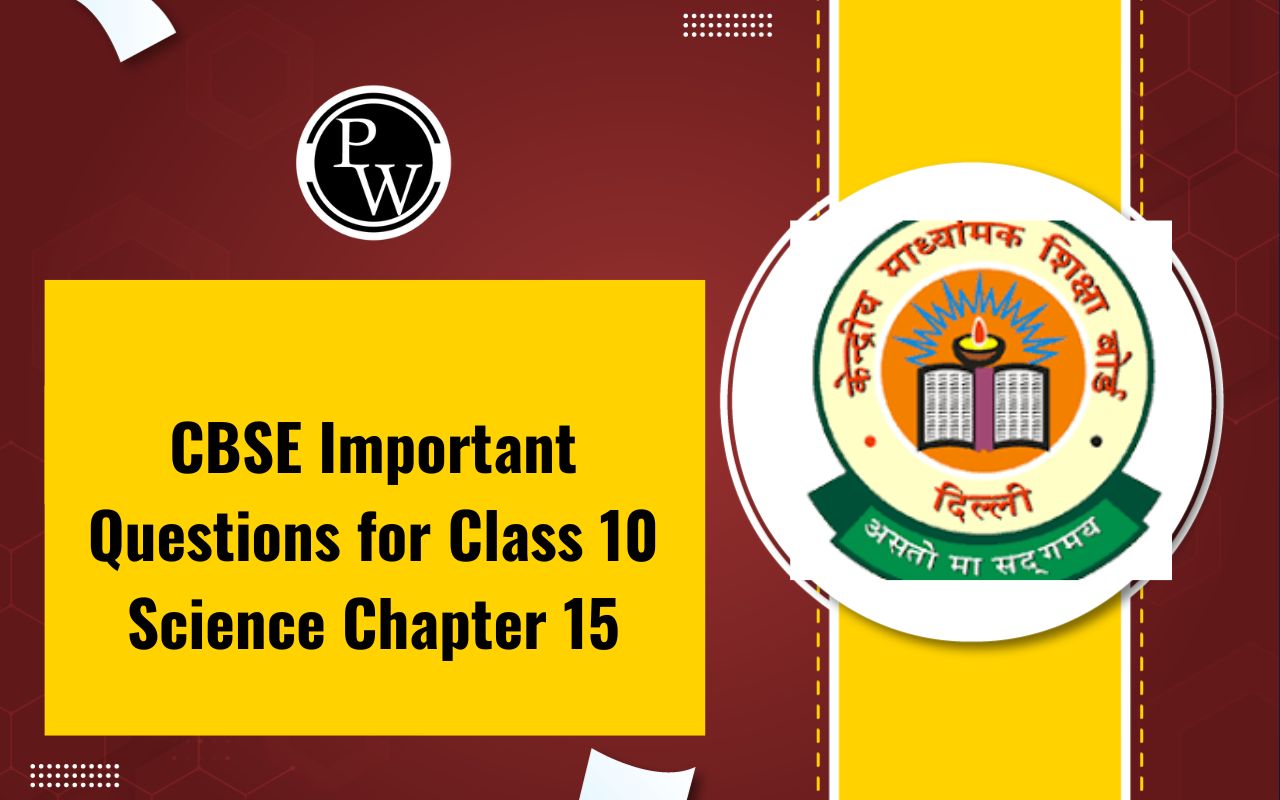

CBSE Important Questions for Class 10 Science Chapter 15: To prepare effectively for Chapter 15 Our Environment students should practice a variety of important questions.
These might include explaining the concept of an ecosystem, identifying the components of food chains and discussing the impact of human activities on the environment. By solving these questions, students can reinforce their understanding of biotic and abiotic factors as well as the importance of biodiversity. Practicing these questions will help them grasp the important concepts of the chapter and emphasize the need for environmental conservation.CBSE Important Questions for Class 10 Science Chapter 15 Overview
The important questions for CBSE Class 10 Science Chapter 15 Our Environment has been prepared by subject experts of Physics Wallah to help students grasp essential concepts. By solving with these expertly created questions, learners can enhance their understanding of environmental science and prepare effectively for their board exams, ensuring a solid foundation for future studies in this critical area.CBSE Important Questions for Class 10 Science Chapter 15 PDF
CBSE Important Questions for Class 10 Science Chapter 15 are available in a PDF format providing a detailed resource for students preparing for their board exams. By studying these questions students can strengthen their understanding of ecosystems, the roles of different organisms, and the effects of human activities on nature. Accessing this PDF will help learners practice effectively and enhance their exam readiness. You can download the PDF using the link provided below.CBSE Important Questions for Class 10 Science Chapter 15 PDF
CBSE Important Questions for Class 10 Science Chapter 15 Our Environment
Here we have provided CBSE Important Questions for Class 10 Science Chapter 15 Our Environment-Question 1. Why is the maximum concentration of pesticides found in human beings?
Answer: Pesticides do not break down easily and accumulate as they move up the food chain. Since humans are at the top of this chain, they end up with the highest levels of these harmful substances in their bodies.Question 2. Give one method to reduce our intake of pesticides through food.
Answer: We can reduce our intake of pesticides by using natural methods to control pests in farming and by washing fruits and vegetables thoroughly before eating them.Question 3. What do the various steps in a food chain represent?
Answer: A food chain represents the flow of energy and nutrients through different levels of organisms in an ecosystem. Each step in a food chain is known as a trophic level, and it illustrates the relationship between organisms based on their feeding habitQuestion 4. What is an ecosystem?
Answer: An ecosystem is a community where living organisms and their non-living surroundings interact. It includes food chains and cycles of materials, creating a stable environment that supports life.Question 5. Why is a lake considered a natural ecosystem?
Answer: A lake is called a natural ecosystem because it supports life without human interference. Plants and animals grow and interact in their environment independently.Question 6. In the following food chain, if plants provide 500 J of energy to rats, how much energy will be available to hawks from snakes?
Answer: According to the 10% rule, if plants give 500 J to rats, the rats will pass on 50 J to snakes, and the snakes will then provide only 5 J of energy to hawks.Question 7. In the following food chain, if 100 J of energy is available to the lion, how much energy was available to the producers?
Answer: Based on the 10% energy transfer rule, if the lion receives 100 J, then the plants (producers) must have had 10,000 J of energy.Question 8. List two biotic components of a biosphere.
Answer:- Producers: These are organisms like green plants that create their own food.
- Consumers: These are animals that cannot make their own food and rely on consuming other organisms.
Question 9. Why are green plants called producers?
Answer: Green plants are known as producers because they make their own food using sunlight, carbon dioxide, and water through the process of photosynthesis.Question 10. In a food chain of frog, grass, insect, and snake, assign a trophic level to the frog.
Answer: In this food chain, the frog is at the third trophic level.Question 11. Why do producers always occupy the first trophic level in every food chain?
Answer: Producers, like green plants, create their own food using sunlight, so they are always the first level in a food chain and serve as food for other organisms.Question 12. What does the term environment mean?
Answer: The environment refers to the surroundings where an organism lives, including both living (biotic) and non-living (abiotic) things.Question 13. Which of the following are always at the second trophic level of food chains? Carnivores, Autotrophs, Herbivores?
Answer: Herbivores always occupy the second trophic level in food chains.Question 14. Which organisms in the food chain will have the highest concentration of non-biodegradable chemicals, and what is this phenomenon called?
Answer: The hawk, being at the top of the food chain, will have the highest concentration of non-biodegradable chemicals due to a process known as biomagnification.Question 15. In a food chain, if 10,000 joules of energy is available to the producer, how much energy will be available to the secondary consumer to transfer it to the tertiary consumer?
Answer: According to the ten percent law, only 10% of the energy from one trophic level is transferred to the next level. Therefore:- Energy available to the primary consumer (herbivore) = 10% of 10,000 J = 1,000 J.
- Energy available to the secondary consumer (carnivore) = 10% of 1,000 J = 100 J.Hence, 100 J of energy will be available to the secondary consumer to transfer it to the tertiary consumer.
Question 16. If 10,000 J of solar energy is available to the grass, how much energy would be available to the deer to transfer it to the lion?
Answer: Using the ten percent law:- Energy available to the deer (primary consumer) = 10% of 10,000 J = 1,000 J.Thus, 1,000 J of energy would be available to the deer to transfer it to the lion.
Question 15. Choose the incorrect statement from the following:
- (a) Ozone is a molecule formed by three atoms of oxygen.
- (b) Ozone shields the surface of the earth from ultraviolet radiations.
- (c) Ozone is deadly poisonous.
- (d) Ozone gets decomposed by UV radiations. (2020)
Question 16 : Write one negative effect on the environment of the affluent lifestyle of a few persons of society. (AI 2016, 2014)
Answer: The affluent lifestyle of a few individuals leads to overconsumption of resources, resulting in their scarcity and increased waste generation, which disrupts environmental balance.Question 17: Why is the excessive use of CFCs a cause of concern? (Foreign 2016)
Answer: Excessive use of CFCs (Chlorofluorocarbons) is concerning because they release active chlorine in the atmosphere, which reacts with ozone molecules, depleting the ozone layer and increasing vulnerability to harmful UV radiation.Benefits of Practicing CBSE Important Questions for Class 10 Science Chapter 15
Practicing CBSE Important Questions for Class 10 Science Chapter 15 (Our Environment) can provide several benefits to students. Here are some key advantages: 1. Enhanced Understanding of Concepts- Reinforcement of Knowledge : Revising important questions helps reinforce fundamental concepts related to ecosystems, food chains, and environmental science.
- Clarification of Doubts : Working through these questions can clarify misunderstandings and solidify knowledge.
- Application of Knowledge : Students learn to apply theoretical knowledge to practical situations, which enhances critical thinking and problem-solving skills.
- Diverse Question Formats : Various types of questions prepares students to tackle different problem formats in exams.
- Familiarity with Exam Format : Practicing important questions familiarizes students with the exam format, reducing anxiety on exam day.
- Time Management : Regular practice helps students manage their time effectively during exams.
- Targeted Revision : Students can identify topics where they struggle, allowing them to focus their revision efforts accordingly.
- Enhanced Focus on Concepts : This targeted approach helps ensure a comprehensive understanding of all concepts.
- Better Grades : Regular practice can lead to improved performance in assessments, contributing to better overall grades.
- Conceptual Clarity : A strong grasp of the chapter’s concepts can lead to higher marks in both formative and summative assessments.
CBSE Important Questions for Class 10 Science Chapter 15 FAQs
What is the environment?
Why is environmental protection important?
What are some common environmental issues?
How can individuals help protect the environment?












